Fractional laser rejuvenation is a know-how in cosmetology. The procedure appeared only recently, but it has already proven positive. It is used by anyone who wants to rejuvenate the skin of their face, neck and hands. It has many indications and few contraindications.
This type of rejuvenation allows you to smooth the skin, remove scars and scars, and even out the tone. The procedure takes a few minutes and the effects last up to five years. Don't many women dream of visiting a salon and staying beautiful for a long time? In any case, you should consult a doctor before registering for a session, as side effects are possible.
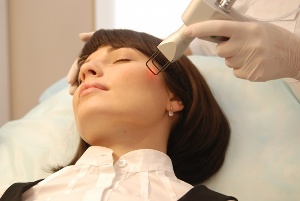
The essence of fractional laser rejuvenation
One of the latest modern developments in the field of cosmetics is the technique of fractional laser rejuvenation. It is currently the most popular of all laser therapy procedures for a reason.
During the session, the laser beam, which is guided through a special breakage grid, breaks up into a large number of micro-beams. This method offers a punctual (fractional) effect on the skin without completely destroying it.
In the dermis layer, many of the smallest healing areas are formed, where the development of the renewed young skin tissue occurs very quickly. The cells around the affected areas begin to divide intensely, filling the damaged areas. This stimulates the rejuvenation processes in the deep layers of the dermis. Micro-rays that act on the middle and top layers of skin tissues help remove pigmentation, wrinkles and scars.
Fractional laser rejuvenation of the facial skin contributes to firmness and elasticity. In addition, thanks to the procedure, the pores are significantly reduced, the oval of the face becomes firmer, the tone and texture of the skin are smoothed, wrinkles and scars are significantly smoothed.
4 types of fractional laser tapering
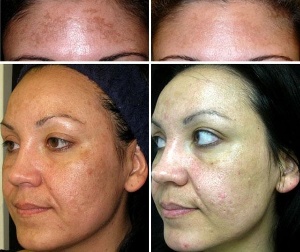
Partly non-ablative laser tapering
On the photo on the right you can see the result after fractional laser tapering of the non-ablative type.
Typically, the method is used to rejuvenate the neck, face and eyelids, as well as to remove stretch marks and acne marks.
During this photothermolysis, the skin is not exposed to any serious damage. Hence, this method is used for lifting and improving the skin condition in general.
During photothermolysis, an erbium laser is used that penetrates the epidermal layer without affecting its integrity.
In addition, a thulium laser (1. 93 Nm) is often used. Thanks to the redistribution of melanin, age spots are removed more effectively and underpigmented areas are healed.
The result of the non-ablative photothermolysis technique is extended. For example, after four acne treatments, the condition of the skin improves within two years. If the goal of photothermolysis is to get rid of stretch marks, the result will exceed expectations: at the end of the course, not only the defect disappears, but also the local tissue gains elasticity.
After the procedure, the wrinkles will decrease for another three months. However, side effects are only reported in 5% of cases.
Ablative way
The technique involves the use of a CO2 laser, the rays of which penetrate certain layers of the dermis and create damage zones there. During this process, proteins in the surface layers of the skin are folded and destroyed. New collagen is formed in the treated areas for three months after the procedure.
This method is used for deep wrinkles, scars, excessive pigmentation, scar tissue and loose skin.
A CO2 laser has a long wavelength of radiation, which allows it to penetrate the deep layers of the dermis and remove significant defects.
In addition, an erbium laser with a shorter wavelength is used. The effect is small, but the result will be seen earlier.
In contrast to non-ablative thermolysis, patients often feel pain during and immediately after the ablative session. At the same time, this method is more effective and safer than classic laser ablation.
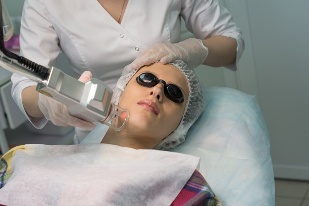
CO2 rejuvenation
The photo shows a variation of the fractional laser rejuvenation process. The use of a CO2 laser with a wavelength of 10. 6 micrometers is assumed. The beam punctually eliminates cells with a defect within the layer of the epidermis. Radiation in the tissue causes the liquid to heat up strongly. In fractional laser rejuvenation using CO2, the evaporation of water causes the breakdown of the structure of some zones while the skin around them maintains its integrity.
With this method, damaged areas are restored thanks to living and active cells.
DOT taper method
This method uses a carbon dioxide laser with a wavelength of 10. 6 μm. The beam falls into the layers of the epidermis and selectively eliminates cells with defects. When changing from damaged and healthy areas, a certain network should form. The coagulation of the protein by the laser beam destroys unwanted cells.
Advantages of fractional laser tapering
This technology has been used in cosmetics for over 10 years. It is effective, safe and has a number of advantages compared to other anti-aging and healing methods:
causes almost no side effects;
is non-invasive, so there is no possibility of client infection (including HIV);
is painless and comfortable enough;
allowed from 16 years;
is hygienic as the tools do not come into contact with the skin;
is suitable for atonic skin types;
It is possible to select an individual treatment program;
is suitable for clients with any degree of skin pigmentation;
Areas with defects are processed selectively, so the possibility of damage to healthy tissue is excluded;
Due to the fact that the skin is only injured by 25%, the recovery time after the procedure is short (face - seven days, body - 14 days);
The effect becomes visible immediately after the first process.
The result obtained is saved for several years.
It is possible to treat sensitive areas;
The elastin production is considerably accelerated in the affected areas.
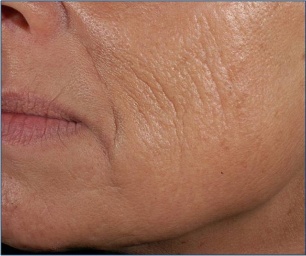
Indications for the
rejuvenation procedureThe fractional laser taper can be used for:
general skin rejuvenation;
Skin tightening (face, neck, décolleté, arms);
Scars and scar smoothing;
skin alignment;
Restore the contour of the face oval;
Wrinkle removal;
Remove age spots and melasma;
Remove stretch marks (stretch marks);
Eliminate the consequences of acne.
Intense fractional laser exposure can briefly lead to hyperpigmentation of the skin.
To achieve a good result, the skin should be treated with sun protection cosmetics with a protection level of at least SPF 50 after the procedure.
Fractional resurfacing can be compared in its effect with solid resurfacing. Judging by the great experience at home and abroad, this hardware technology is less traumatic and leads to an enormous rejuvenation and tightening effect.
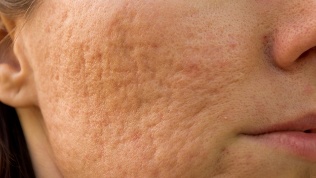
Fractional rejuvenation for the treatment of scars and stretch marks
This rejuvenation method is particularly effective in treating scar tissue. Fractional laser beams have the ability to crush coarse scar tissue, after which it acquires elasticity, softness and the tension of the surrounding healthy tissue decreases.
Fractional photothermolysis helps shrink the area of the scars, making them elastic, inconspicuous and as close as possible to healthy skin.
Fractional rejuvenation is indicated for the treatment of stretch marks. Unfortunately, stretch marks cannot be completely eliminated. You can only make them more invisible.
The effect of fractional healing is:
decrease the area of the stretch marks;
Reduction of tissue fiber breaks;
aligns stretch marks on a healthy skin tone;
Increases the elasticity and firmness of the skin tissue and relieves tension.
Contraindications to such rejuvenation
Fractional rejuvenation, as with any cosmetic procedure, is not shown to everyone. Therefore, in order to avoid negative consequences, all contraindications must be carefully examined before the session.
Fractional photothermolysis is not recommended:
during pregnancy and while breastfeeding, since any changes in the body of a pregnant or breastfeeding woman will affect the baby - you shouldn't put the baby's health at risk. It is better to postpone the procedure.
in case of inflammation (or redness) in the treated area - the beautician refuses to perform fractional laser photothermolysis in the cheeks if they are covered with an allergic rash (the laser beam can damage the skin up to deep scars);
for chemical peel - Once you've cleaned your face, you need to let the layers of the epidermis thicken and prepare for the laser beam for at least two weeks;
in oncological diseases, as natural complications can occur as a result of laser exposure;
for diagnosed diabetes mellitus;
in the presence of viral and bacterial infections - to avoid the penetration of foreign elements into the cell structure during fractional rejuvenation, you must first fully recover.
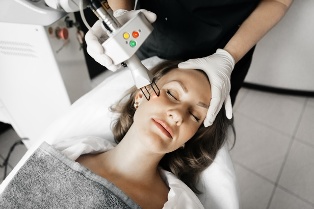
Preparation and execution of the procedure
To avoid catastrophic consequences in the form of complications after a cosmetic procedure, you need to carefully prepare for it.
First of all, you need to consult a beautician and get an assessment of the skin condition on the face. The specialist determines the list of contraindications and gives the necessary recommendations.
Before the procedure, it is not advisable to visit the bathhouse, sauna and solarium for 3-4 weeks. It is also forbidden to bask in the open sun. Sunscreen should be applied to the face before going outside.
It is very important to stop certain medications, especially antibiotics and blood thinners. In addition, doctors recommend taking antiherpetic drugs.
It is not recommended to carry out manipulations that injure the skin tissue at least two weeks in advance.
The fractional laser rejuvenation of the eyes and other areas takes place in several stages. First of all, the beautician has to prepare the skin areas for the procedure. To do this, it removes the remains of decorative cosmetics from the skin, as well as dirt, dust and sweat. Then the surface is treated with an antiseptic
The next step is to apply an anesthetic cream that will remain on the skin for about an hour.
After the anesthesia, a contact gel is evenly applied to the face so that the sensor glides evenly and evenly over the surface of the skin.
Then the tip is used to treat the skin tissue in straight lines in multiple directions. The device is equipped with attachments of different sizes. As a rule, 2 cm² of leather are processed in one go.
At the end of the procedure, the specialist should remove the remaining contact gel and apply a soothing cream.
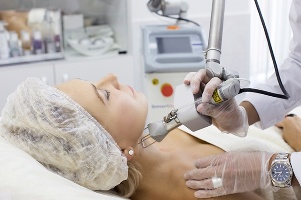
Number of sessions
After fractional laser rejuvenation of the eyelids and other problem areas, rehabilitation is required for 3 to 7 days. The length of the rehabilitation period depends on the patient's lifestyle. For example, bad habits, poor diet, excessive physical activity, stress, and sleep disorders can significantly slow down skin regeneration after the procedure.
During the first three days after the session, redness and slight swelling may appear on the skin. Pain relievers and skin cooling products can be used to reduce discomfort.
It is considered normal for the skin to appear taut for the first week and peeling off in some places. Side effects include a bronze complexion that disappears after 14 days.
Two to five procedures can produce long lasting results. In particular, depending on the individual case and the initial data of the customer, the beautician can specify how many sessions are required.
The interval between the sessions should be at least 3-4 weeks. Fractional laser rejuvenation slows down aging: wrinkles decrease or disappear completely, the turgor increases, the pores narrow and the complexion is evened out. This method effectively removes pigmentation, acne, stretch marks and scars.
Possible side effects
Complications after fractional laser rejuvenation are extremely rare. Most often, negative consequences are noted due to the unprofessional acts of a beautician, neglecting the processing instructions. Sometimes side effects occur because the client does not follow the skin care recommendations.
Most likely complications:
pronounced skin hyperemia, self-limiting after three days;
swellings;
dark skin tone;
excessive dryness and flaking of the skin;
burns;
scars and scars;
white or yellow milia that rise above the surface (dense nodules that form under the skin);
inflammatory processes in the damaged areas;
the phenomenon of hyperpigmentation (can occur through exposure to sunlight).
Complications after fractional laser rejuvenation will not occur if you prepare in time before the procedure, choose a reliable clinic and an experienced professional.
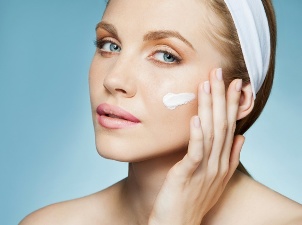
7 tips for follow-up treatment
To restore the skin quickly, you need to follow the recommendations below:
Try not to overheat the treated areas within 7-10 days. You can't go to the bathhouse, sauna. It is not recommended to visit the solarium for 1. 5 months.
The products prescribed by the beautician should be applied to the skin.
If the body has been treated, wear compression clothing.
Treat the skin with moisturizers at least 2-3 times a day.
Participate in a regeneration of masks that contain a stimulant for tissue regeneration.
Appeared crusts cannot be removed.
It is forbidden to do peelings, to use peelings and aggressive cleaning agents.
Fractional Laser Rejuvenation Price
The price of fractional laser facial rejuvenation depends on the area of the treatment areas and the penetration depth of the rays. Some cosmetic clinics offer their customers price lists in which the processing costs of 1 cm² are specified.
The cost depends on the number of sessions performed.
The best result can be obtained if the treatment is carried out in courses calculated by a professional beautician.

Frequently asked questions about fractional laser rejuvenation
Minimum age for laser facial rejuvenation
There are practically no restrictions. Treatments can be done as early as 17 years of age to remove acne scars.
For women after 40 years of age who want to retain youth and attractiveness, the technique is particularly useful, as laser beams provoke the production of collagen by skin cells.
The recovery time after fractional laser rejuvenation is usually 7 to 14 days. The duration of rehabilitation depends on the complexity of the problem and the type of laser exposure.
When can I
start?It depends on what type of laser treatment was used, on the area of the problem areas, on the experience and skills of the beautician. The recovery time, based on the method and the complexity of the defects, is anywhere from two days to three weeks. It happens that the patient can start work as early as a day after the session.
How long does it take before the result
is displayedIt takes about six months for the skin to be completely renewed and noticeable. The result lasts for about five years.
Fractional laser facial skin rejuvenation refers to highly effective cosmetic procedures. It has many advantages over similar anti aging treatments. However, you need to know that this procedure is not for everyone and it has contraindications. Therefore, you need to contact a specialist first. To reduce the risk of complications, you should only choose reliable and proven clinics.










